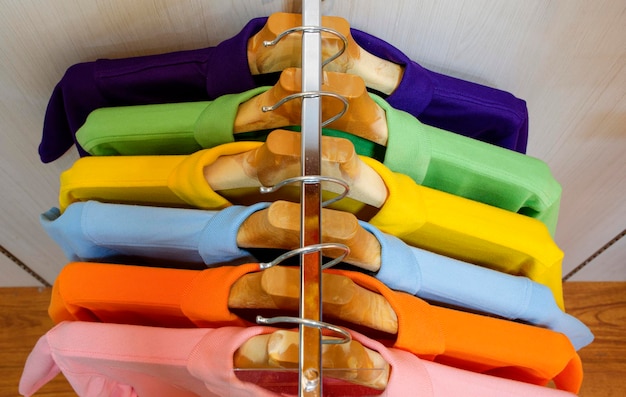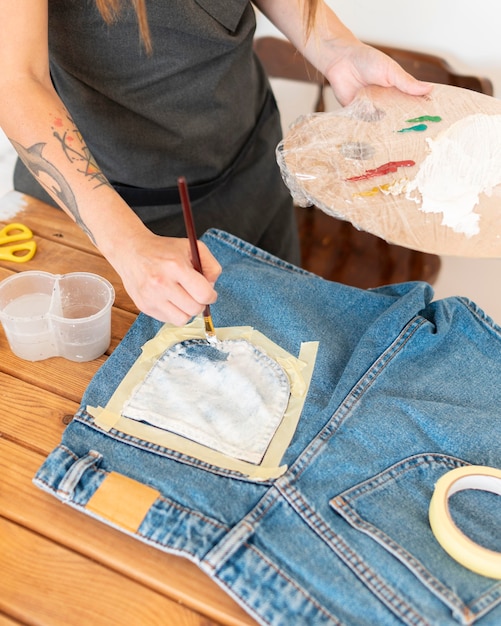Sustainable Style: 3 Easy Ways to Refresh Your Wardrobe

Sustainable style is achievable by revamping your wardrobe without buying new items; try swapping clothes, upcycling old pieces, or creatively restyling outfits for a fresh look.
Want to embrace sustainable style without breaking the bank or contributing to fast fashion? It’s easier than you think! Discover three simple yet impactful ways to revamp your wardrobe using what you already own, making you look stylish and eco-conscious.
Embrace the Eco-Chic: Sustainable Style Defined
Sustainable style is more than just a trend; it’s a conscious choice to minimize the environmental impact of your fashion choices. It’s about extending the life of your clothes and reducing waste. By adopting sustainable style practices, you can look great while also contributing to a healthier planet.
It’s not about deprivation; it’s about creativity and resourcefulness. Embracing sustainable style allows you to express your unique personality while making a positive impact. Let’s dive into some practical ways to transform your wardrobe without spending a dime.

Clothing Swap: A Fun and Frugal Fashion Fix
One of the most enjoyable and cost-effective ways to refresh your wardrobe is through a clothing swap. Organize a swap with friends, family, or even local community groups. It’s a great way to get rid of items you no longer wear and find new treasures that fit your current style.
Clothing swaps are not only sustainable but also a social event. Invite your friends over, provide snacks and drinks, and make an afternoon of trying on clothes. You’ll be surprised by the hidden gems you can find and the joy of giving your unwanted items a new home.
How to Organize a Clothing Swap
Organizing a successful clothing swap requires a bit of planning. Here are some tips to ensure your swap is a hit:
- Set a Date and Time: Choose a time that works for most of your guests. Weekends are often ideal.
- Invite Guests: Send out invitations well in advance. Specify the type of clothing you’re looking to swap (e.g., casual wear, professional attire).
- Establish Rules: Decide on the number of items each person can bring and how the swapping will work. For instance, you can implement a token system where each item is worth a token, and guests can use tokens to “buy” new items.
- Provide a Space: Set up a dedicated space for trying on clothes, with mirrors and seating.
By organizing or participating in clothing swaps, you’re fostering a community of fashion lovers who are committed to sustainable style. It’s a win-win for your wardrobe and the environment.
Upcycling: Turning Trash into Trendy Treasures
Upcycling is the art of transforming old or unwanted items into something new and valuable. This approach to sustainable style is incredibly rewarding, allowing you to unleash your creativity and create truly unique pieces that reflect your personal style.
Upcycling not only saves you money but also reduces textile waste, which is a significant environmental problem. By giving new life to old clothes, you’re contributing to a more circular economy and reducing the demand for new, resource-intensive materials.
Creative Upcycling Ideas
The possibilities for upcycling are endless. Here are a few ideas to inspire your upcycling journey:
- Denim Transformation: Turn old jeans into shorts, skirts, or even a stylish tote bag.
- T-Shirt Remix: Cut up old t-shirts to create a patchwork quilt, reusable shopping bags, or unique headbands.
- Sweater Upgrade: Transform an old sweater into a cozy pillow cover or a pair of mittens.
- Button Bonanza: Use leftover buttons to embellish clothing, create jewelry, or decorate picture frames.
Upcycling encourages you to see the potential in what others might consider trash. With a little imagination and some basic sewing skills, you can create one-of-a-kind pieces that showcase your sustainable style.

Restyling: Mastering the Art of Outfit Remixing
Often, the key to a fresh wardrobe isn’t about acquiring new clothes but about learning to restyle what you already own. Experimenting with different combinations and accessories can breathe new life into your existing pieces. This sustainable style approach is all about maximizing the versatility of your wardrobe.
Restyling is also a great way to rediscover items you may have forgotten about. Take a look through your closet with fresh eyes and consider new ways to wear your favorite pieces. You might be surprised by the creative possibilities that emerge.
Tips for Effective Restyling
To master the art of outfit remixing, consider these tips:
- Assess Your Wardrobe: Take everything out of your closet and try on each item. Identify pieces that you love and those that you’re willing to experiment with.
- Mix and Match: Try pairing items that you wouldn’t normally wear together. Don’t be afraid to break the “rules” of fashion.
- Accessorize Creatively: Use belts, scarves, jewelry, and hats to transform the look of an outfit.
- Seek Inspiration: Look to fashion blogs, social media, and magazines for restyling ideas.
By embracing restyling, you can create a seemingly endless array of outfits with the pieces you already have. This sustainable style technique is both budget-friendly and environmentally conscious.
Accessorize Smart: The Power of Finishing Touches
Accessories can significantly impact your overall look, allowing you to transform outfits without buying new clothes. Choosing accessories that complement your style and values is a key component of sustainable style. They elevate and revitalize your existing clothing with minimal environmental impact.
Start by evaluating your wardrobe basics. Determine which accessories will provide the most versatility and impact. Building a collection of classic, well-made accessories ensures they will endure for years to come, boosting your outfits and style.
Smart Accessory Strategies
- Belts: Belts are your secret weapon for defining your waist or layering over oversized pieces.
- Scarves: A beautiful scarf can add a pop of color, print, or texture to any outfit turning a plain outfit into statement
- Jewelry: Choose well-made jewelry that you can wear everyday. Also, consider vintage or reused jewelry for a more sustainable style.
- Hats: From sunhats to beanies, hats can fully transform the feel of an outfit.
Investing in carefully selected fashion accessories allows you to create versatile looks while staying committed to sustainable style.
Mindful Consumption: Building a Sustainable Wardrobe
Embracing sustainable style isn’t just about modifying your existing wardrobe—it also involves a shift in your purchasing habits. Instead of engaging in impulse buys and quick-fix fashion, opting for mindful consumption entails making thoughtful, long-lasting investments that align with your ethical and environmental values.
Mindful consumers consider the environmental and social impact of their fashion choices. From labor standards to waste reduction, being aware will help to ensure that each purchase aligns with environmental values. It’s about investing in clothing that you’ll love for years to come and items that are gentle on the planet.
Tips for Conscious Shopping
- Buy Less: Challenge yourself to purchase only what you truly need and will love.
- Invest in Quality: Choose well-made items that will endure for years, over items that may only last a few washes.
- Support Sustainable Brands: Research brands that prioritize ethical labor practices, eco-friendly materials, and waste reduction.
- Consider the Source: Think whether the item is made out of sustainable components and how it was produced.
Being more conscious of your purchase decisions is essential with building a sustainable style. It’s about aligning your purchases with your values.
Proper Garment Care: Extending the Life of Your Clothes
One of the most effective ways to embrace sustainable style is by practicing proper garment care. By taking good care of your clothes, you can significantly extend their lifespan, reducing the need for frequent replacements and minimizing waste. Proper maintenance is what keeps your current clothing in tip-top condition.
Simple tips, like washing your clothes in cold water, hanging clothing to dry, and protecting your wardrobe, you can keep your clothing looking fresh. Additionally, take the time to learn basic sewing skills to repair minor damage to your clothes.
Tips for Garment Care
- Wash properly: It is essential to keep in mind the clothes color for proper care. Wash white and dark clothing separately.
- Avoid Overwashing: Only wash clothes when they are truly dirty. Overwashing can damage fabrics and cause colors to fade.
- Use Gentle Detergents: Opt for eco-friendly detergents that are gentle on fabrics and the environment.
- Store Them Well: Store clothes in a dark, dry place to protect them from light.
Practicing proper garment care is an essential part of sustainable style. It’s about taking responsibility for the clothing you own and ensuring it lasts as long as possible.
| Key Point | Brief Description |
|---|---|
| ♻️ Clothing Swap | Exchange clothes with friends for a wardrobe refresh. |
| 🧵 Upcycling | Transform old items into new, stylish pieces. |
| 🔄 Restyling | Mix and match existing clothes for new outfits. |
| 🌱 Mindful Consumption | Make thoughtful, sustainable purchasing choices. |
FAQ
▼
Sustainable style is about making fashion choices that minimize environmental impact. It’s important because it reduces waste, conserves resources, and promotes ethical labor practices in the fashion industry.
▼
To host a successful clothing swap, invite a group of friends with similar clothing sizes, set rules for trading, designate a space for trying on clothes, and provide refreshments to make it a fun and engaging event.
▼
Beginners can start with simple projects like cutting old t-shirts into reusable shopping bags or transforming old denim jeans into stylish tote bags. These projects require minimal sewing skills and can be completed quickly.
▼
Accessories like scarves, belts, and jewelry can transform outfits without requiring new clothing purchases. Vintage or ethically sourced accessories also add a unique touch while supporting sustainable practices.
▼
Proper garment care extends the life of your clothing, reducing the need for frequent replacements. Simple practices like washing clothes in cold water and avoiding excessive drying keep clothes looking better for longer.
Conclusion
Embracing sustainable style is not only a responsible choice but also an opportunity to express your creativity and individuality. By swapping clothes, upcycling old pieces, practicing mindful consumption and mastering the art of restyling, you can create a wardrobe that is both stylish and environmentally conscious. It’s time to choose style that cares for the planet, one outfit at a time.
